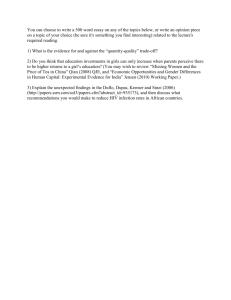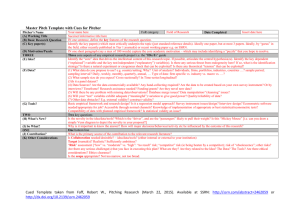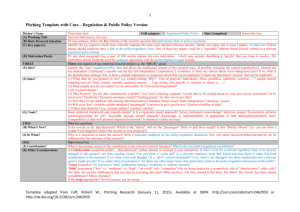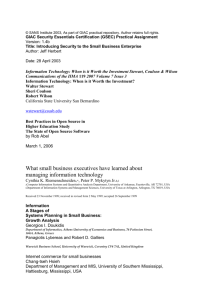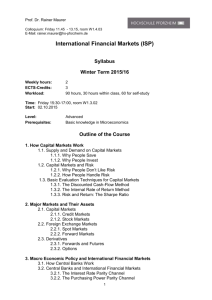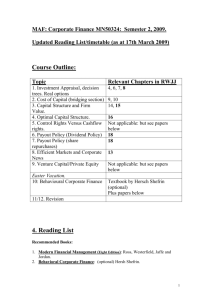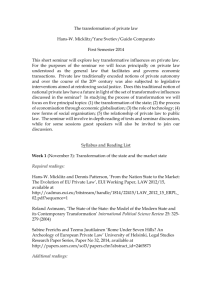AC 540 Syllabus-1
advertisement
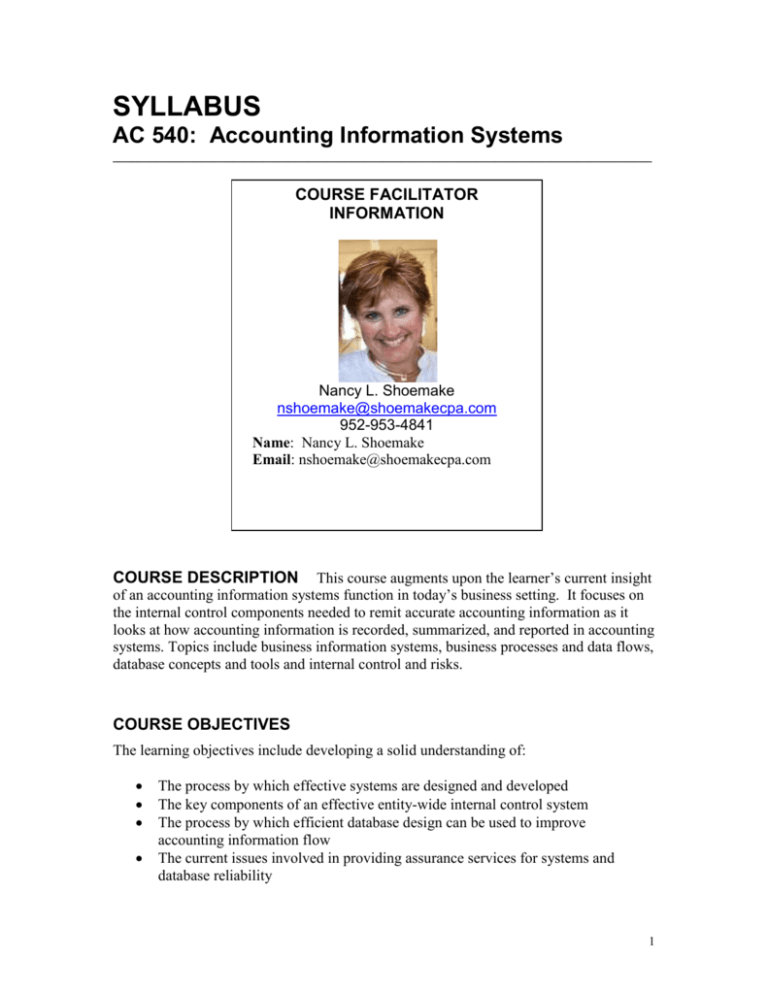
SYLLABUS AC 540: Accounting Information Systems ______________________________________________________________________________________ COURSE FACILITATOR INFORMATION Nancy L. Shoemake nshoemake@shoemakecpa.com 952-953-4841 Name: Nancy L. Shoemake Email: nshoemake@shoemakecpa.com This course augments upon the learner’s current insight of an accounting information systems function in today’s business setting. It focuses on the internal control components needed to remit accurate accounting information as it looks at how accounting information is recorded, summarized, and reported in accounting systems. Topics include business information systems, business processes and data flows, database concepts and tools and internal control and risks. COURSE DESCRIPTION COURSE OBJECTIVES The learning objectives include developing a solid understanding of: The process by which effective systems are designed and developed The key components of an effective entity-wide internal control system The process by which efficient database design can be used to improve accounting information flow The current issues involved in providing assurance services for systems and database reliability 1 An awareness of the role of information and accounting systems in business management An enhanced comprehension of business enterprises and business processes An understanding of internal control over financial reporting and information systems Cognizance with the development, documentation, control and audit of accounting information systems COURSE FORMAT In this 10-week online course, you will acquire the skills outlined in the course objectives through the following: Readings from the textbook and articles provided Lecture notes Active dialogue with your fellow learners via weekly discussions questions Class Participation: You are expected to participate in the online dialogue at a minimum of three times per week per discussion question, preferably on nonconsecutive days (Monday, Wednesday, Friday). Written assignments to synthesize the course content. Final exam. How Your Participation Will Be Graded Read “How Your Participation Will Be Graded,” located on the course homepage, and study the Dialogue Rubric provided. Each week there is a required, but not graded, discussion thread – Lessons Learned – where you are expected to post your reflections on the past week’s learning activities. In so doing, you will share your thoughts and feelings on both the process and content of the past week with everyone. WRITTEN ASSIGNMENTS All written assignments are not to exceed the maximum page limit noted in the assignment’s instructions – anything beyond the maximum page limit will not be 2 read. All submissions are to be Microsoft Word documents with one-inch margins, double-spaced, using 12-point Times New Roman font. For more information on how your written assignments will be graded, please see the Rubric for Written Assignments at the end of this Syllabus. REQUIRED TEXT Gelinas, U. J., & Dull, R. B. (2009). Accounting information systems (8th ed.). Mason, OH: Southwestern Publishing. ISBN: 0324663803, 978-0324663808. REQUIRED ARTICLES Week 1 Willis, M. (March 2005). XBRL and data standardization: Transforming the way CPAs work. Journal of Accountancy, Vol. 199, Iss. 3, pp. 80-81. http://www.journalofaccountancy.com http://www.journalofaccountancy.com/Issues/2005/Mar/XbrlAndDataStandardiza tionTransformingTheWayCpasWork.htm Week 2 Pulling it All Together with Unified Communications – DQ #1 http://www.internet.com http://www.internet.com/Microsoft/Everybodys_Business/Article/40988 The Compelling Case for Conferencing (once in the website, scroll down the right-hand side to find this article) – DQ #1 http://www.internet.com http://www.internet.com/microsoft/everybodys_business/article/40988 Preparing Data Flow Diagrams http://www.idinews.com http://www.idinews.com/life-cycle/dataflow.html Lehman, M. W. (October, 2000). Flowcharting made simple. Journal of Accountancy, Vol. 190, No. 4, pp. 77-88. http://www.journalofaccountancy.com http://www.journalofaccountancy.com/Issues/2000/Oct/FlowchartingMadeSimple .htm Week 3 SQL as an Audit Tool http://ezrstats.com 3 http://ezrstats.com/doc/SQL_As_An_Audit_Tool.pdf Week 4 Ross, J. W., & Beath, C. (December 2007). Agility and risk management at Pacific Life: Optimizing business unit autonomy. CISR Working Paper No. 372; MIT Sloan Research Paper No. 4692-08. Available at SSRN: http://papers.ssrn.com http://papers.ssrn.com/sol3/papers.cfm?abstract_id=1114796 Canada, J., Kuhn, J. R., & Sutton, S. G. (March 2009). The pervasive nature of IT controls: An examination of material weaknesses in IT controls and audit fees. DQ #2 Available at SSRN http://papers.ssrn.com http://papers.ssrn.com/sol3/papers.cfm?abstract_id=1393515 Week 5 Pathak, J. (January 2003). Controls, approach & IT audit judgment: A case. University of Windsor Working Paper No. 2003-03. Available at SSRN: http://papers.ssrn.com http://papers.ssrn.com/sol3/papers.cfm?abstract_id=373762 Control of Corporate Decisions – Shareholders versus Management DQ #3 http://faculty.chicagobooth.edu/finance http://faculty.chicagobooth.edu/finance/papers/Control%20of%20Corporate%20D ecisions.pdf SAP Thought Leadership – Customer Relationship Management DQ #4 http://www.sdn.sap.com http://www.sdn.sap.com/irj/scn/go/portal/prtroot/docs/library/uuid/0018c790bd9b-2c10-98a8-9254a675a0ea?QuickLink=index&overridelayout=true Week 6 Mann, R. J. (Oct 2003). Regulating Internet payment intermediaries. Univ. of Texas Law, Public Law Research Paper No. 54. Available at SSRN: http://papers.ssrn.com http://papers.ssrn.com/sol3/papers.cfm?abstract_id=446420. Reiner, G., & Hofmann, P. (December 2006). Efficiency analysis of supply chain processes. International Journal of Production Research, Vol. 44, No. 23, 1, 5065–5087. Available at SSRN: http://papers.ssrn.com http://papers.ssrn.com/sol3/papers.cfm?abstract_id=1078585. 4 Week 7 Splettstoesser, I. (Oct 2008). Comfy Casuals Corporation – Should they upgrade? York University. Available at SSRN: http://papers.ssrn.com http://papers.ssrn.com/sol3/papers.cfm?abstract_id=1190142. Fotaki, M., et al., Human resources turnover as an asset acquisition, accumulation, and divesture process. Department of Management Science and Technology. Athens University of Economics and Business. Available at SSRN: http://papers.ssrn.com http://papers.ssrn.com/sol3/papers.cfm?abstract_id=1325645. Gardner, T. M., et al. (Aug 2007). The influence of human resource practices and collective affective organizational commitment on aggregate voluntary turnover. Available at SSRN: http://papers.ssrn.com http://papers.ssrn.com/sol3/papers.cfm?abstract_id=1089190. Week 8 Cervantes, P. (2008). Sarbanes-Oxley and the outsourcing of accounting. University of Arizona. Available at: http://michiganjb.org http://michiganjb.org/issues/21/text21d.pdf. Centolella, P., & Ott, A. (March 2009). The integration of price responsive demand into PJM: Wholesale Power Markets and System Operations. Available at: http://www.hks.harvard.edu http://www.hks.harvard.edu/hepg/Papers/2009/Centolella%20%20Ott%20PJM%2 0PRD%2003092009.pdf. Plumlee, D., & Plumlee, M. A. (Feb, 2008). Assurance on XBRL for financial reporting. Available at SSRN: http://ssrn.com http://ssrn.com/abstract=1104245. Week 9 Oprea, D., & Mesnita, G. (June 2006). The information systems documentation Another problem for project management. Managing Information in the Digital Economy: Issues & Solutions – Proceedings of the 6th IBIMA Conference, Khalid S. Soliman, ed., pp. 332-338, IBIMA. Available at SSRN: http://ssrn.com http://ssrn.com/abstract=946785. 5 Supplemental Reading List (optional) Week 1 Articles The role of IR in Sarbanes-Oxley Section 404 http://wistechnology.com/articles/2587/ Sarbanes-Oxley Section 404: The ‘Section’ of Unintended Consequences and its Impact on Small Business http://www.aeanet.org/governmentaffairs/AeASOXPaperFinal021005.asp Reducing SOX Section 404 Compliance Costs a Top-Down, Risk-Based Approach by Patrick O’Brien http://www.nysscpa.org/cpajournal/2006/706/essentials/p26.htm Week 2 Articles Dillon, T. W., & Kruck, S. E. (2004). The emergence of accounting information systems programs: As more and more companies seek out accounting professionals with IT skills, some universities now are offering a major in accounting information systems, which mixes topics from each area to provide students with the requisite skills employers want. Management Accounting Quarterly. Available at: http://findarticles.com/p/articles/mi_m0OOL/is_3_5/ai_n6272118/?tag=content;col 1. Week 3 Articles Dospinescu, O., Fotache, D., & Munteanu, A. B. (June 18, 2006). Technologies for data processing on enterprise integrated applications. Second International Conference on Business, Economics and Management, Yasar University, Izmir Turkey. Available at SSRN: http://ssrn.com/abstract=905191. Week 5 Articles Van Bruggen, G. H., & Wierenga, B. (August 2005, 09). When are CRM systems successful? The perspective of the user and of the organization. ERIM Report Series Reference No. ERS-2005-048-MKT. Available at SSRN: http://ssrn.com/abstract=828168. INTERNET RESOURCES Writing Argumentative Essays (Does this apply to the Master of Accountancy assignments?) Papyr.com: http://papyr.com/ http://papyr.com/hypertextbooks/comp2/critique.htm 6 Gallaudet University: http://www.gallaudet.edu/ http://aaweb.gallaudet.edu/CLAST/Tutorial_and_Instructional_Programs/English_Works /Writing/Essays/Writing_Argumentative_Essays.html Research Websites American Institute of Certified Public Accountants: www.aicpa.org Financial Accounting Standards Board: www.fasb.org Governmental Accounting Standards Board: www.gasb.org Public Company Accounting Oversight Board: www.pcaobus.org Securities and Exchange Commission: www.sec.gov Guide Star (information about nonprofit organizations): http://www2.guidestar.org/ Internal Revenue Service: www.irs.gov International Financial Reporting Standards: www.ifrs.com International Accounting Standards Board: www.iasb.org Department of Labor: www.dol.gov Government Accountability Office: www.gao.gov American Accounting Association: http://aaahq.org/ascLogin.cfm Saint Joseph’ College of Maine User ID: AAA52608 Password: ssjc508 7 Other Links The CPA Journal Online (for non-authoritative literature): http://www.cpajournal.com/ Bloomberg Business Week: www.businessweek.com Federal Trade Commission: www.ftc.gov National Association of State Boards of Accountancy: www.nasba.org The Institute of Internal Auditors: www.theiia.org Mental Model Musings Systems Thinking: http://www.systems-thinking.org/ Wellehan Library at Saint Joseph’s College http://www.sjcme.edu/library/index.htm To access the library online databases, please use the following link: http://www.sjcme.edu/library/databases Websites as Information Source: Proceed with Caution There is far greater peril in buying knowledge than in buying meat and drink. – Plato The Internet is increasingly becoming a part of our lives. We, as consumers, find it so convenient to let our fingers do the shopping. Because of a concern for security, early on many of us were cautious about purchasing items on the Internet. But, for most, these concerns have been addressed by technology through encryption software, firewalls, etc. However, when consuming information, technology can’t protect us from becoming infected with bad information. Just because it is available on the Internet doesn’t mean that it is safe to consume (i.e., use). As James Steiner said in 1993 in the New Yorker, “on the Internet nobody knows you’re a dog.” Therefore, it pays to be an informed consumer of Internet information. Since technology can’t protect us, it is imperative that we learn how to evaluate the credibility of the websites we use. 8 The following websites provide more detailed “how to” information on this very important issue. It is critically important that you – students and faculty alike – use any of the following websites to build your understanding of how to evaluate the credibility of the sources of information you find on the Internet. Purdue University http://www.purdue.edu/ http://owl.english.purdue.edu/handouts/research/r_evalsource4.html New Mexico State University www.nmsu.edu/ http://lib.nmsu.edu/instruction/evalcrit.html University of British Columbia www.ubc.ca/ http://www.library.ubc.ca/home/evaluating/ Johns Hopkins University www.jhu.edu/ http://www.library.jhu.edu/researchhelp/general/evaluating/ Cornell University www.cornell.edu/ http://www.library.cornell.edu/olinuris/ref/research/webeval.html UC Berkeley www.berkeley.edu/ http://www.lib.berkeley.edu/TeachingLib/Guides/Internet/Evaluate.html Student Resources SUBMITTING ASSIGNMENTS Instructions on how to submit your assignment to your instructor can be found on the Assignment Drop Tool feature on the course homepage. COURSE POLICIES AND PROCEDURES Current information regarding College policies affecting your course can be found on the Resources/Policy section of the course homepage. On this page, you will find vital information, including the following: Current Student Handbook outlining course-specific policies 9 Access to support resources, including advising and online tutorial services Student Success Guides You are expected to relate the reading to your experiences and to engage in both critical and creative thinking on the topics by exploring and entertaining mind-expanding questions that stretch the boundaries of what is accepted as “the way things are.” NOTE: It is not expected that each and every article read will stimulate explorations of the mind, but it is expected that you will find that some articles each week will generate mind-stretching ideas. The criteria for evaluation/grading of this will be based upon the following: Relevance of stated key points Appropriateness of the application of concepts Depth of reflections Evidence of productive inquiry Synthesis of concepts AC 540: SCHEDULE FOR TOPICS, READINGS, AND ASSIGNMENTS Week # Readings Assignments Learning Objectives Week 1 Define accounting Read Chapter 1 & 2 in textbook. information system (AIS) and Read Articles for Week 1. information concepts. Respond to DQ #1, #2 and Lessons Learned. Understand the accountants changing role in AIS. Begin Assignment #1. Week 2 10 Use proper documentation to develop an understanding of the accounting information system. Read Chapter 3 & 4 in textbook. Respond to DQ #1, #2 and Lessons Learned. Read Articles for Week 2. Week 3 Examine how a systems process is used when developing new or modifying existing information systems. Read Chapters 5 & 6 in textbook. Respond to DQ #1, #2 and Lessons Learned. Read Articles for Week 3. Submit Assignment #1. Week 4 Evaluating risk management needs for internal controls. Read Chapters 7 & 8 in textbook. Respond to DQ #1, #2 and Lessons Learned. Read Articles for Week 4. Begin Assignment #2. Week 5 Controlling information for business processes. Read Chapters 9 & 10 in textbook. Respond to DQ #1, #2 and Lessons Learned. Read Articles for Week 5. Week 6 Understanding the receivables process. Read Chapters 11 & 12 in textbook. Respond to DQ #1, #2 and Lessons Learned. Read Articles for Week 6. Submit Assignment #2. Week 7 Evaluating the payables process. Read Chapters 13 & 14 in textbook. Respond to DQ #1, #2 and Lessons Learned. Read Articles for Week 7. Begin Assignment #3. 11 Week 8 Understanding internal controls Read Chapters 15 & 16 in textbook. Respond to DQ #1, #2 and Lessons Learned. Read Articles for Week 8. Week 9 Examining system documentation Read Chapter 17 in textbook. Respond to DQ #1, #2 and Lessons Learned. Read Articles for Week 9. Submit Assignment #3. Week 10 Summary of AIS Wrap-Up Respond to DQ #1 and #2. Final Exam Assignment #1 – The Annual Report: Communicating Accounting Information The annual report is one of the most important printed documents that an entity will produce. Annual reports are large documents that may have numerous sections. These various sections include a financial review, management discussion and analysis, segment reporting, letters to shareholders, descriptions of the business, operating highlights, inflation data, as well as the financial statements. This increase in the annual report is a result of the degree of sophistication and complexity in accounting standards and disclosure requirements for financial reporting. This expansion reflects the change in the composition and level of sophistication of stakeholders. Current users include shareholders, potential investors, lending institutions, financial and securities analysts, customers, employees, and competitors. Requirements Prepare a 6-8 page paper that includes the following: Identify and discuss the core factors of communication that must be considered in the presentation of an annual report. Discuss the communication problems an entity may face in preparing the annual report as a result of the stakeholder diversity. Select two types of information found in an annual report and describe how they benefit the stakeholders (do not use financial statements or footnotes). 12 Discuss three advantages and three disadvantages of stating well-defined corporate strategies in the annual report. Evaluate the effectiveness of annual reports in fulfilling the information needs of shareholders, creditors, customers, analysts, and employees. Discuss how public access to the annual report affects information that is provided therein. Assignment #2 – Complete Problem P7-6 on pages 249-250. Respond to all questions. Would you purchase a higher level of service from the ISP? If so, what level of service would you purchase? Defend your answer both quantitatively and qualitatively in a report to management. Assignment #3 – The purpose of this project is to fully document an existing business process in a “real world” organization and to evaluate its efficiency, effectiveness, and quality of internal controls. Choose a company where the end result affects the accounting information of the organization. You should avoid an organization that is too wide in scope to be manageable. Understand the process by interviewing individuals in the organization along with your direct observation. Understand and provide a table of entities and activities, an annotated table of entities and activities, a context dataflow diagram, a physical dataflow diagram, a level 9 logical dataflow diagram, lower-level dataflow diagrams, and a system flowchart. Create a matrix that provides an efficiency goal and a security goal in addition to information process goals for input validity, input completeness, and input accuracy. Submit a final report containing an executive summary, details of the project, and your recommendations for process improvements. These suggestions may be in regard to the controls needed in the process, the efficiency of the process, ways in which the process could be improved with technology, or any other items you deem appropriate. This assignment should be a minimum of 10 pages, excluding the title and reference pages. WEEKLY SCHEDULE Please note that each new week begins on Wednesday and ends on Tuesday. Remember, you will need to participate in the online dialogue at a minimum of three times per week per discussion question, preferably on non-consecutive days. Online dialogue is ongoing every day throughout the week. 13 GRADING PLEASE NOTE: Late assignments will receive a 10 percent penalty for each day late. If the assignment is more than two days late, it will not be accepted unless prior written agreement was obtained from the course facilitator. Class Participation/Discussions ....................................................................................30% Assignments (Weeks 1 - 8) ........................................................................................... 30% Final Assignment/Project (Due Week 9) ......................................................................20% Final Exam (Due Week 10)……………………………………………………………20% Minimum of 10 pages and a maximum of 12 pages (Times New Roman, 12-point font, double-space, 1-inch margins). PLEASE NOTE: If an extra-ordinary event in life gets in the way of your graduate school responsibilities, then you must notify your facilitator as soon as you determine that an event will happen that will inhibit you from participating at the required depth and level. Your facilitator is here to help you learn as much as you can and needs to know what is happening in order to facilitate your learning. A Note on Our Approach: Facilitating vs. Teaching Assuming your educational experiences have been largely in a traditional teachercentered environment, it is instructive and important to provide an understanding of the facilitative learner-centered approach – which will be the strategy employed in this course – and the implications this approach has for your role in the learning process. Take a moment to recall your previous experiences in school. If your experiences were like mine – and they most likely were – then your classrooms were a place where you sat passively listening and taking notes as your teacher lectured and transmitted (usually irrelevant) facts. What was your role, your expectation? You were the audience for the teacher’s monologue. You were expected to take good notes, memorize the important facts, and provide feedback at test time of exactly what your teacher transmitted. If you did this, then you would pass the course and move on. Hence, your role was as the passive recipient of facts that your teacher deemed important. Why was school like this? The assumptions upon which this approach is grounded include the following: 1. The student’s experiences are of little or no value as a resource in the learning process. 14 2. The student is highly dependent upon the teacher (the expert). 3. Students, as well as teachers, have a subject-centered orientation to learning. 4. Students learn for the grade, not for the usefulness of the material transmitted. Why is this online class following a facilitation learner-centered strategy? Why change? Adult learners are problem-centered learners; they need to see and understand the relevance of what they are learning. Adults have experiences that can add immeasurably to the quality of the learning experience. Moreover, adults are self-directed and do not particularly like having the will of another (in this case the teacher) imposed upon them. When these assumptions are the basis of the instructional strategy, then we learn better, with greater depth, and enjoy the learning process. So, how does this change the role of teacher and student? The teacher becomes a facilitator and the student a learner. Both the facilitator and the learner have the same objective: to maximize their learning. Both are partners in the learning process. Therefore, each shares in the responsibility to collaborate – to labor together – toward the common objective: learning. The learning process changes from monologue to dialogue. The facilitator, unlike the teacher, can no longer “do for” or “do to” the passive student. The facilitator must “do with” by providing the support, context, content, and, most importantly, the challenging questions that will guide learning. Correspondingly, the adult learner can no longer assume a passive role; rather, he/she must fully engage in the learning process by being an active participant. This means both facilitator and learner must come to the online classroom fully prepared to learn and advance understanding in a meaningful and relevant way. Both must come to the classroom prepared to exchange ideas. In short, read the material, think about and reflect on what was read, raise questions that will deepen understanding, and utilize and share relevant experiences – bring it to life. The Forum/Learning Environment: This impartial forum encourages critical thinking and demands the respect of the opinions and expressions of all participants as we move through the learning process. “Transcendence takes us from possibility to structure, from uncertainty to choice, from disorder to a new order…” (T. Stone) Facilitator’s Role in Dialogue It is important that you know what the facilitator’s role and intentions are relative to your participation in dialogue in this course. When you post, you are not posting to the course facilitator; you are posting to your classmates. This is your class, and your exchange of information and real-life examples/experiences facilitate learning. 15 The facilitator’s role is to facilitate this exchange. In facilitating, the facilitator will not and cannot respond to everyone’s posting. That is really not the point. Typically, facilitators respond to a posting that he/she feels will help highlight a point or guide the dialogue in a certain direction. If your post is not chosen as the one the facilitator responds to, please do not feel slighted. The facilitator will not respond to each and every posting, regardless of how clearly insightful they may be. Your facilitator will, however, provide you with weekly feedback shortly after the end of each week. For more information, look at the Participation Grading Rubric on the course home page. Online Dialogue: What Is Expected of You 1. Your class participation is based on the frequency and substance of your postings in the ongoing, weekly dialogues. Engaging in dialogue is an essential learning activity and a core component of this course. 2. Experience shows that when students distribute their postings throughout the week (e.g., Wednesday/Friday/Sunday; or Thursday/Saturday/Monday; or even Wednesday/Friday/Sunday), the likelihood of productive dialogue increases. The important point here is that you are required to engage in dialogue at a minimum of three non-consecutive days per week per discussion question. Since ongoing dialogue is a primary means to gaining knowledge and developing understanding in this course, posting all at once just before or after the week ends cannot contribute to these ends; nor will it contribute to your grade for participation. In order to substantively contribute and actively participate in the building of knowledge in the course, you will need to make every effort to space your postings sufficiently over time. By doing so, you will facilitate productive exchanges with others. 3. If life gets in the way of your classroom responsibilities, then you must notify your facilitator as soon as you suspect events will happen that will inhibit you from participating at the required level. Your facilitator is here to help you learn as much as you can, and he/she needs to know what is happening in order to facilitate your learning. 4. You are required to substantively contribute to the many dialogues each and every week. Substantive postings are not lengthy; they are thoughtful. You are expected to add value to the dialogue – moving it along, making progress – by offering your critical and creative thoughts and by building upon the thoughts and comments of others. 5. We will follow the Socratic Method in our discussions. For guidance, see http://www.criticalthinking.org/articles/becoming-a-critic.cfm. Because we are following the Socratic Method in responding to the weekly dialogue 16 issues/questions, all postings in response to discussion questions should be to the point, concise, and succinct; specifically, less than 250 words in length. It is critical to be concise and succinct in your postings. Get to the point, and do not include unnecessary content. Do not summarize the required readings but rather communicate your understanding. 6. The purpose of engaging in dialogue is to extend your learning and deepen your understanding of concepts presented in the course. The expectation is not to have everyone repeat what was read in the week’s readings but to share ideas, perspectives, experiences, and understanding – always trying to go beyond what we (currently) know. 7. Posting a summary of what you have read or what you consider important does not equate to making a substantive contribution – no matter how accurate the posting. Substantive contributions are not merely postings with a sizable word count; they are postings that demonstrate new knowledge or the pursuit thereof. Therefore, a substantive posting means that it demonstrates that you have invested time in reflecting and thinking deeply about the various issues presented in the course readings and the questions posed, initiating the particular dialogue. 8. At the end of each week, the facilitator will provide a Lessons Learned section in the discussion area. You are expected to post your reflections on the week’s activity in this section. That is, you will reflect on what was discussed during the week and how the dialogue affected your learning. This is an informal, but required, posting which is not a graded/evaluated activity but an important activity nonetheless. RUBRIC FOR EVALUATING WRITTEN ASSIGNMENTS Written assignments will be evaluated according to the following criteria: TOTAL (xx/100) Content (xx/50) The content of the paper/essay aligns with the objectives of the assignment/course – has proper focus and scope. The content is accurate in its presentation. There is an absence of unnecessary content. Analysis is performed at the requisite depth and reflects a good understanding of subject matter through sound logic and reasoning that underlies the argument. Content reflects a synthesis of information and perspectives – course content (concepts, principles, etc.) is synthesized to form a reasoned argument. Clear presence of the writer’s voice is appropriately supported with integrated application of course concepts and principles – essay is not merely a compilation and summary of course content. 17 Organization (xx/20) The beginning introduces a relevant topic and clearly expresses the main idea. The body paragraphs include topic sentences that are directly and logically tied to the main idea of the paper (thesis). There is a clear beginning (introduction), middle (body), and end (conclusion) to the essay – paper is logically structured in support of its purpose. Each paragraph is well organized and includes a topic sentence, supporting details, and a summary of the ideas – paragraphs are coherent and logical in structure. The conclusion ties the ideas in the body back to the thesis and summarizes why the issue is interesting or important. Readability (xx/15) The thought process is easily followed – ideas are connected and flow one to the other. Coherence devices (transitions, repetition, synonyms, pronoun references, etc.) are used effectively within and between paragraphs. Each paragraph is well organized and includes a topic sentence, supporting details, and a summary of the ideas. Sentences are well constructed with consistently strong, varied sentences. Sentence transitions are present and maintain the flow of thought. Mechanics/Grammar/Word usage (xx/15) Rules of grammar, usage, and punctuation are followed. The paper is spell-checked. The paper is proofread and does not have serious and/or frequent errors in grammar, spelling, typing, or punctuation. The paper is double-spaced and has appropriate margins all around. Complies with APA 6th edition guidelines (e.g., references, headings, citations) – see SJC Library resources and http://owl.english.purdue.edu <http://owl.english.purdue.edu/owl/resource/560/01/>. 18
